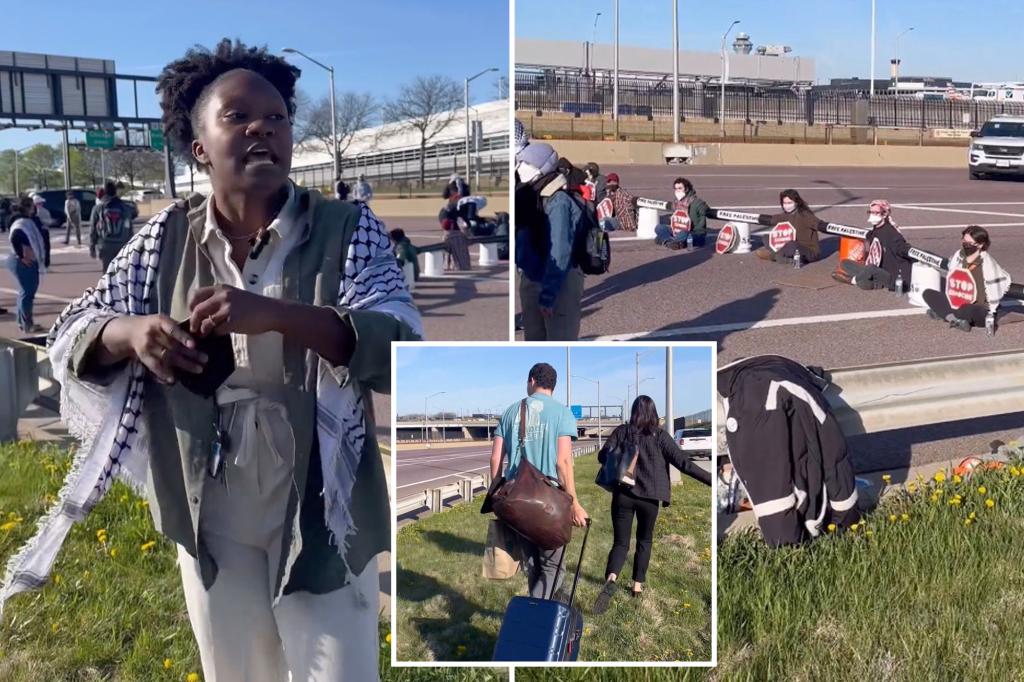Pro-Palestinian activists staged a protest blocking an access road to Chicago’s O’Hare International Airport in an effort to send a message to Boeing, a corporation that sells weapons to Israel for use in its conflict with Hamas. The protesters, many of whom were dressed in keffiyeh scarves and carrying signs with messages like “Free Palestine” and “Stop Genocide,” blocked the road by sitting in the middle of Interstate 190 with their arms interlocked using long tubes to prevent cars from accessing the airport. The group organizing the protest, Chicago Dissenters, stated that their goal was to disrupt business as usual at the airport to draw attention to the ongoing conflict in Gaza, fueled by American-funded bombings.
Passengers flying out of O’Hare on that day were encouraged to consider alternative transportation methods to reach the airport due to the protest. The disruption caused by the activists led to some travelers having to get out of their cars and walk to the terminals, as videos of the protest circulated on social media platforms like Instagram. The protesters chose O’Hare International Airport due to its status as one of the largest in the country and a hub for travel, seeking to draw attention to the impact of American-funded bombings on Palestinian civilians in Gaza. The demonstration aimed to raise awareness of the role of corporations like Boeing in providing weapons used in the conflict and highlight the connection between US tax dollars and the violence in the region.
The protest made headlines as a breaking news event, with updates being shared as the situation unfolded. The use of direct action by the anti-Israel protesters at O’Hare International Airport attracted attention and sparked a debate on social media and in the news. The activists’ decision to block the access road to the airport was a bold move to disrupt the flow of travel and draw attention to the ongoing conflict in the Middle East. By targeting a major transportation hub like O’Hare, the protesters aimed to amplify their message and place pressure on corporations like Boeing to reconsider their involvement in selling weapons used in the conflict between Israel and Hamas.
The organizers of the protest framed their action as a response to the ongoing bombardment of Gaza, funded by American tax dollars and carried out with weapons supplied by corporations like Boeing. By choosing Tax Day as the date for their demonstration, the activists sought to draw attention to the role of US government funding in fueling the violence in the region. The protest at O’Hare International Airport was intended to disrupt the normal operations of the airport and make a statement about the impact of American support for Israel in the conflict. The use of social media platforms like Instagram to share videos and updates from the protest helped to spread awareness and engage a wider audience in the conversation about the situation in Gaza and the involvement of US corporations in providing weapons for the conflict.
Passengers affected by the protest were advised to plan for delays and consider alternative transportation options to reach the airport. The disruption caused by the activists highlighted the tension between the right to protest and the impact on travelers and airport operations. While the protest generated attention and raised awareness about the issue of American-funded bombings in Gaza, it also raised questions about the effectiveness and consequences of using direct action to make a political statement. The decision to block access to an airport as a form of protest sparked debate about the balance between freedom of expression and the right to travel, as well as the responsibilities of corporations in conflict zones. Overall, the protest at O’Hare International Airport served as a flashpoint for discussions about the ongoing conflict in the Middle East and the role of American entities in supporting it.


